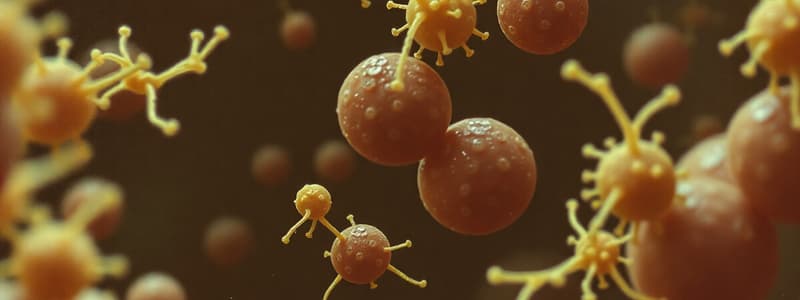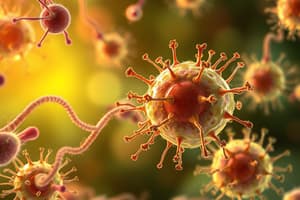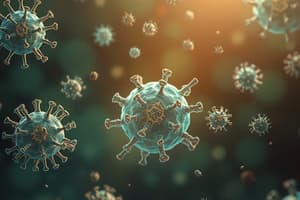Podcast
Questions and Answers
Which of the following best defines microbiology?
Which of the following best defines microbiology?
- The study of organisms too small to be seen by the naked eye. (correct)
- The study of large multicellular organisms.
- The study of the human skeletal system.
- The study of the Earth's atmosphere.
Prions, which are infectious proteins, are a recent addition to the list of microbes studied in microbiology.
Prions, which are infectious proteins, are a recent addition to the list of microbes studied in microbiology.
True (A)
Name three disciplines within the field of microbiology.
Name three disciplines within the field of microbiology.
Bacteriology, Mycology, Virology
The study of fungi and yeast is known as ______.
The study of fungi and yeast is known as ______.
Match the following disciplines of microbiology with their respective focus:
Match the following disciplines of microbiology with their respective focus:
Which of the following is NOT a typical role of microorganisms in the environment?
Which of the following is NOT a typical role of microorganisms in the environment?
Microorganisms are only detrimental and have no beneficial roles in food production.
Microorganisms are only detrimental and have no beneficial roles in food production.
Describe one way in which microorganisms are important in food safety.
Describe one way in which microorganisms are important in food safety.
The use of microbes to clean up pollution is known as ______.
The use of microbes to clean up pollution is known as ______.
Match the following roles of microorganisms with an example:
Match the following roles of microorganisms with an example:
Who is credited with first observing 'animalcules' using a microscope?
Who is credited with first observing 'animalcules' using a microscope?
Robert Hooke is known for his contributions to cell theory.
Robert Hooke is known for his contributions to cell theory.
Who proposed that cells arise from pre-existing cells?
Who proposed that cells arise from pre-existing cells?
The scientist who introduced a staining method to differentiate bacteria is ______ Gram.
The scientist who introduced a staining method to differentiate bacteria is ______ Gram.
Match the following scientists with their respective contributions to microbiology:
Match the following scientists with their respective contributions to microbiology:
Which of the following is NOT associated with Louis Pasteur's contributions?
Which of the following is NOT associated with Louis Pasteur's contributions?
Edward Jenner is best known for his work on pasteurization techniques.
Edward Jenner is best known for his work on pasteurization techniques.
Name the scientist who accidentally discovered penicillin.
Name the scientist who accidentally discovered penicillin.
Joseph Lord Lister is known for his work on ______, particularly in surgical wound infection.
Joseph Lord Lister is known for his work on ______, particularly in surgical wound infection.
Match the following scientists with their contribution to microbiology:
Match the following scientists with their contribution to microbiology:
What substance did Walter Hesse introduce as a solidifying agent for media?
What substance did Walter Hesse introduce as a solidifying agent for media?
Richard Petri is best known for developing staining techniques to classify bacteria.
Richard Petri is best known for developing staining techniques to classify bacteria.
What contribution did Dimitri Ivanovski make to the field of virology?
What contribution did Dimitri Ivanovski make to the field of virology?
Raymond Sabouraud developed culture media to specifically study ______ and molds.
Raymond Sabouraud developed culture media to specifically study ______ and molds.
Which of the following antibiotic was discovered by Selman Waksman
Which of the following antibiotic was discovered by Selman Waksman
The idea of spontaneous generation was supported by Francesco Redi's experiments.
The idea of spontaneous generation was supported by Francesco Redi's experiments.
Aristotle proposed the idea of spontaneous generation. What does this theory suggest?
Aristotle proposed the idea of spontaneous generation. What does this theory suggest?
Louis Pasteur's ________ Experiment helped to disprove the Abiogenesis debate.
Louis Pasteur's ________ Experiment helped to disprove the Abiogenesis debate.
Match the scientist with their contribution
Match the scientist with their contribution
Flashcards
Microbiology
Microbiology
The study of organisms too small to be seen by the naked eye.
Bacteriology
Bacteriology
A branch of microbiology that studies bacteria.
Mycology
Mycology
A branch of microbiology that studies fungi and yeast.
Virology
Virology
Signup and view all the flashcards
Parasitology
Parasitology
Signup and view all the flashcards
Immunology
Immunology
Signup and view all the flashcards
Biological roles of microbes
Biological roles of microbes
Signup and view all the flashcards
Bioremediation
Bioremediation
Signup and view all the flashcards
Animalcules
Animalcules
Signup and view all the flashcards
Robert Hooke
Robert Hooke
Signup and view all the flashcards
Cell Theory
Cell Theory
Signup and view all the flashcards
Cell arise from pre-existing cells
Cell arise from pre-existing cells
Signup and view all the flashcards
Carolus Linnaeus classification
Carolus Linnaeus classification
Signup and view all the flashcards
Endospores
Endospores
Signup and view all the flashcards
Louis Pasteur discoveries
Louis Pasteur discoveries
Signup and view all the flashcards
Edward Jenner's contribution
Edward Jenner's contribution
Signup and view all the flashcards
Francesco Redi's experiment
Francesco Redi's experiment
Signup and view all the flashcards
Alexander Fleming's discovery
Alexander Fleming's discovery
Signup and view all the flashcards
Joseph Lord Lister contribution
Joseph Lord Lister contribution
Signup and view all the flashcards
Walter Hesse's contribution
Walter Hesse's contribution
Signup and view all the flashcards
Richard Petri's contribution
Richard Petri's contribution
Signup and view all the flashcards
Christian Gram's contribution
Christian Gram's contribution
Signup and view all the flashcards
Selman Waksman discovery
Selman Waksman discovery
Signup and view all the flashcards
Aristotle's spontaneous generation
Aristotle's spontaneous generation
Signup and view all the flashcards
Koch's Postulates
Koch's Postulates
Signup and view all the flashcards
Koch's Postulates
Koch's Postulates
Signup and view all the flashcards
The Golden Age of Microbiology
The Golden Age of Microbiology
Signup and view all the flashcards
Louis Pasteur disproved Abiogenesis
Louis Pasteur disproved Abiogenesis
Signup and view all the flashcards
Study Notes
- Microbiology is the study of organisms too small to be seen with the naked eye.
- Microbes or microorganisms, commonly called "germs" or "bugs", include bacteria, viruses, fungi, algae, protozoa, and helminths.
- Prions ("infectious proteins") have been recently added to the list of microbes.
Disciplines of Microbiology
- Bacteriology: The study of bacteria.
- Mycology: The study of fungi and yeast.
- Virology: The study of viruses.
- Parasitology: The study of parasitic protozoans and helminths.
- Immunology: The study of the humoral and cellular immune response to disease agents and allergens.
Importance of Microbiology
- Biological roles include functioning as decomposers, recyclers, and symbionts.
- Microbes aid in animal digestion, especially in ruminants.
- Food microbiology involves the production of yogurt, cheese, beer, bread, etc.
- Microbes contribute to food safety by preventing putrefaction and disease.
- Microbes are used in the production of complex drug molecules like insulin.
- Bioremediation uses microbes to clean up pollution.
- Pathogenicity refers to bacteria and viruses that cause illness.
- Fundamental biology utilizes microbes to understand most biochemical pathways.
History of Microbiology
- Anton Van Leeuwenhoek discovered 'animalcules'.
- Robert Hooke discovered cells.
- Schwann developed cell theory.
- Robert Koch lived from 1843-1910.
- Rudolf Virchow stated that cells arise from pre-existing cells.
- Carolus Linnaeus is known for classification.
- Ferdinand Cohn discovered endospores.
- Louis Pasteur contributed to vaccines, pasteurization, and Germ Theory.
- Edward Jenner developed vaccines.
- Jablot Louis disproved spontaneous generation.
- Francesco Redi disproved spontaneous generation.
- Alexander Fleming (1929) accidentally discovered penicillin.
- Paul Ehrlich (1890s) contributed to vaccines.
- Joseph Lord Lister developed antiseptics for surgical wound infection, known as the Father of Antiseptic Surgery.
- Walter Hesse (1846-1911) used Agar as a solidifying agent for media.
- Richard Petri (1852-1921) used the agar dish for providing a large area for growth.
- Christian Gram (1853-1935) introduced a staining method to demonstrate bacteria and distinguish between Gram-positive and Gram-negative bacteria.
- Raymond Sabouraud (1890-1910) developed culture media to study yeast and molds.
- Dimitri Ivanovski (1892) found that the tobacco mosaic virus could pass through filters used to remove bacteria.
- Selman Waksman (1940) discovered a number of antibiotics such as Tetracycline and Streptomycin.
- Reska (1938) developed the first electron microscope.
- Watson and Crick, Franklin, and Wilkins discovered DNA.
Spontaneous Generation
- Aristotle (384-322 B.C.) proposed spontaneous generation, stating that living things can arise from nonliving matter.
- Francesco Redi's experiments:
- Decaying meat kept isolated from flies did not develop maggots.
- Meat exposed to flies soon became infested.
- Scientists began to doubt Aristotle's theory.
Louis Pasteur
- Louis Pasteur ended the Abiogenesis debate with his Goose Neck Flask Experiment.
- He discovered the germ theory but couldn't prove it.
- He is considered the father of microbiology.
- Microbes caused fermentation, leading to the discovery of the Germ Theory.
- Studied spoilage of wine, dairy products, etc., and introduced “Pasteurization" to prevent it.
- Used cotton plugs in his cultures to prevent air borne contamination and devised the Aseptic Technique.
- His discovery of pasteurization led him to introduce the "germ theory of disease" in 1864.
- Diseases are caused by the growth of microbes in the body and not by sins, bad character, or poverty.
Germ Theory of Diseases and Koch's Postulates
- Robert Koch (1843 - 1910) established the relationship between Bacillus anthracis and anthrax using criteria developed by Jacob Henle (1809-1895).
- His criteria became known as Koch's Postulates, used to establish the link between a particular microorganism and a disease.
- Koch's Postulates:
- The causative agent must be present in all affected organisms but absent in healthy individuals.
- The agent must be capable of being isolated and cultured in pure form.
- When the cultured agent is introduced to a healthy susceptible organism, the same disease must occur.
- The same causative agent must be isolated again from the affected host.
Golden Age of Microbiology
- The period from 1860 to 1900 is often named the Golden Age of Microbiology.
- Rapid advances, spearheaded by Louis Pasteur and Robert Koch, led to the establishment of microbiology as a science.
- Scientists searched for answers to questions such as:
- Is spontaneous generation of microbial life possible? (Aristotle, Jablot, Redis, Louis Pasteur)
- What causes fermentation? (Louis Pasteur)
- What causes disease? (Louis Pasteur, Robert Koch)
- How can we prevent infection and disease?
Emerging Infectious Diseases (EID)
- Occurrence of new diseases and increasing incidence of old ones (EID)
- Factors include:
- (a) evolutionary changes in existing organisms
- (b) spread of known diseases into new geographical areas by modern transportation
- (c) ecological changes resulting in the introduction of unusual agents
- (d) emergence of antimicrobial resistance
Examples of EIDs
- West Nile Encephalitis was first diagnosed in Uganda in 1937 and appeared in New York City in 1999.
- Invasive Group A Streptococcus is also known as the "flesh-eating bacteria."
- Escherichia coli 0157:H7 causes "bloody diarrhea" and hemorrhagic uremic syndrome (HUS).
- Bovine Spongiform Encephalopathy (BSE) or "mad cow" disease is caused by prions.
- Acquired Immunodeficiency Syndrome (AIDS) is caused by HIV, with Africa being the hardest hit.
- Anthrax, caused by Bacillus anthracis, was sensationalized in 2001 when spores were disseminated via the mail.
- H5N1 Avian Influenza (Bird Flu).
- Three flu pandemics have occurred in the past century, including the Spanish flu of 1918, Asian flu of 1957, and the 1968 Hong Kong flu.
- Smallpox is a contagious disease caused by a virus that originated over 3,000 years ago in India or Egypt
Other EIDS
- H1N1 Swine Influenza A (Swine Flu).
- Ebola (1976).
Trends in Diseases
- Diseases that are increasing include:
- AIDS, Avian Influenza, Ebola, Marburg, Cholera, Rift Valley Fever, Typhoid, Tuberculosis, Leptospirosis, Malaria and Dengue
- Diseases that are decreasing include:
- Guinea worm, Smallpox, Yaws, Poliomyelitis, Measles, Leprosy and Neonatal tetanus.
Studying That Suits You
Use AI to generate personalized quizzes and flashcards to suit your learning preferences.




